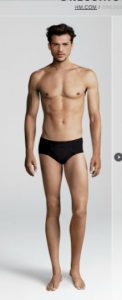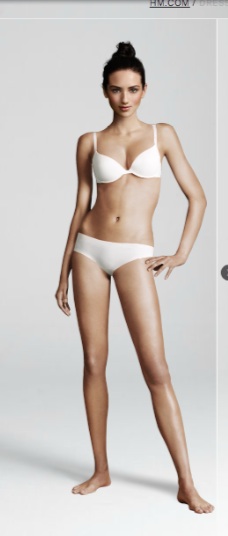by Bailey Shoemaker Richards
 H&M seems to have decided that the bodies of real women are no longer good enough for displaying their clothes, according to Jezebel. A photo from the H&M website reveals the identical (if racially diverse) bodies of swimsuit models, with the heads of real models pasted on. The most baffling part of the whole thing, at least to me, is that H&M feels these virtual bodies display the clothes better than real women can.
H&M seems to have decided that the bodies of real women are no longer good enough for displaying their clothes, according to Jezebel. A photo from the H&M website reveals the identical (if racially diverse) bodies of swimsuit models, with the heads of real models pasted on. The most baffling part of the whole thing, at least to me, is that H&M feels these virtual bodies display the clothes better than real women can.
Given that the clothes are designed for actual human women and girls, not virtual bodies, I’m not sure how that’s a good idea from a marketing standpoint. Displaying clothes on an unattainable and fake body won’t give customers a good idea of how the clothes will fit them, regardless of how diverse they made the models. The fact that these virtual bodies are used as a type of “paper doll” for pasting different outfits on is equally problematic.
If H&M wanted to give consumers a virtual template for putting clothes on, why create one identical and unrealistically proportioned model? Wouldn’t it have been a better idea to make (or, I don’t know, hire) a group of models with diverse body shapes and sizes to give girls a real idea of how their clothes will fit?
One argument in favor of the virtually created models seems to be that they are no different than store mannequins and “it’s not that big of a deal.” Except for the fact that they are completely different from store mannequins. Store mannequins are plastic, often headless and don’t resemble real human people. No one is going to confuse the body of a mannequin with a living person.
These pictures are different, and that difference is insidious. The bodies of these models look like real, airbrushed women, which means the implicit message is that real women and girls can and should strive to look like them. Few girls are going to aspire to look like a store mannequin. Plenty of girls and women want to be models, and draw inspiration from pictures of models found in magazines and online. The virtual nature of these bodies is disguised, making them seem more attainable, even though they’re not.
Additionally, the idea of a “paper doll” model has some uncomfortable elements of objectification, as though H&M is offering up the bodies of these models to be our playthings, reinforcing that the female body is made to be looked at (although it must be said that the male model on the H&M site is equally objectified and, if possible, even less realistic looking).
The changing of real people’s bodies through Photoshop and airbrushing into a body that is no longer really theirs is something we’re all used to. We expect that models on the covers of magazines to have had their teeth, hair, skin, eyes, height, breasts, legs, arms, waists, butts, and faces shaped and airbrushed beyond reality. However, the creation of entirely new virtual bodies is not something that consumers have come to expect and anticipate in their shopping experience, and it sends a very unpleasant message to women: even Photoshop can’t make your bodies good enough for our clothes.
Sign our petition at Change.org and tell H&M that this practice is unacceptable and needs to change.
